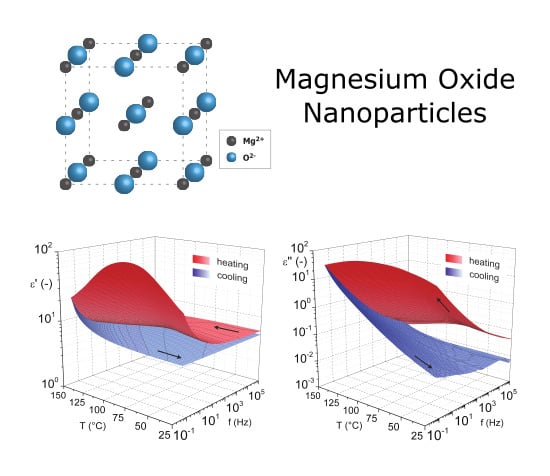Magnesium Oxide Nanoparticles: Dielectric Properties, Surface Functionalization and Improvement of Epoxy-Based Composites Insulating Properties
Abstract
1. Introduction
2. Dielectric Properties of MgO Nanoparticles via Broadband Dielectric Spectroscopy
2.1. Preparation of MgO Pellet
2.2. Comprehensive Analysis of Relative Permittivity
3. Improvement of Epoxy Based Composites Insulating Properties
3.1. Production of Epoxy-Based Nanocomposites Samples
3.2. Dielectric Properties of Epoxy-Based MgO Nano-Composites
3.3. X-ray Diffraction of Epoxy Resin and Epoxy Resin with Dispersed MgO Nanoparticles
4. Surface Functionalization and Effect on Dielectric Properties
4.1. Production of Epoxy-Based Nano-Composites Samples with Treated Surface of MgO Filler
4.2. Dielectric Properties of Epoxy-Based Nanocomposites with Treated Surface of MgO Filler
4.3. Dielectric Response Measurement
4.3.1. Reduced Resorption Curves Analyses
4.3.2. Voltage Response Analyses
4.4. X-ray Diffraction of Epoxy-Based Nanocomposites with Treated Surface of MgO Filler
5. Conclusions
Author Contributions
Acknowledgments
Conflicts of Interest
References
- Marfunin, A.S. Advanced Mineralogy: Volume 1 Composition, Structure, and Properties of Mineral Matter: Concepts, Results, and Problems; Springer: Berlin, Germany, 1994; ISBN 978-3-642-78525-2. [Google Scholar]
- Shand, M.A. The Chemistry and Technology of Magnesia; John Wiley & Sons: Hoboken, NJ, USA, 2006; ISBN 9780471980575. [Google Scholar]
- Haynes, W.M.; Lide, D.R. CRC Handbook of Chemistry and Physics: A Ready-Reference Book of Chemical and Physical Data; CRC Press: Boca Raton, FL, USA, 2011; ISBN 978-1-4398-5511-9. [Google Scholar]
- Zhang, B.; Peng, J.; Zhang, L.; Ju, S. Optimization of preparation for magnesium oxide by calcination from basic magnesium carbonate using response surface methodology. In Magnesium Technology; Mathaudhu, S.N., Sillekens, W.H., Neelameggham, N.R., Hort, N., Eds.; Springer: Cham, Germany, 2012; pp. 75–79. ISBN 978-3-319-48203-3. [Google Scholar]
- Vu, A.H.; Jiang, S.; Kim, Y.H.; Lee, C.H. Controlling the physical properties of magnesium oxide using a calcination method in aerogel synthesis: its application to enhanced sorption of a sulfur compound. Ind. Eng. Chem. Res. 2014, 53, 13228–13235. [Google Scholar] [CrossRef]
- Costa, D.; Chizallet, C. Water on extended and point defects at MgO surfaces. J. Chem. Phys. 2006, 125, 054702. [Google Scholar] [CrossRef] [PubMed]
- Li, Q.; Zhang, S.I.; Wang, J.P.; Gao, H. Process analysis of MgO film on NdFeB magnet by sol–gel method. Surf. Eng. 2009, 25, 589–593. [Google Scholar] [CrossRef]
- Sharma, G.; Soni, R.; Jasuja, N.D. Phytoassisted synthesis of magnesium oxide nanoparticles with Swertia chirayaita. J. Taibah Univ. Sci. 2017, 11, 471–477. [Google Scholar] [CrossRef]
- Wilson, L.O. Magnesium oxide as a high-temperature insulant. IEE Proc. A Phys. Sci. Meas. Instrum. Manag. Educ. Rev. 1981, 128, 159. [Google Scholar] [CrossRef]
- Senbayram, M.; Gransee, A.; Wahle, V.; Thiel, H. Role of magnesium fertilisers in agriculture: Plant-soil continuum. Crop. Pasture Sci. 2015, 66, 1219–1229. [Google Scholar] [CrossRef]
- Purwajanti, S.; Zhou, L.; Nor, Y.A.; Zhang, J.; Zhang, H.; Huang, X.; Yu, C. Synthesis of magnesium oxide hierarchical microspheres: A dual-functional material for water remediation. ACS Appl. Mater. Interfaces 2015, 7, 21278–21286. [Google Scholar] [CrossRef] [PubMed]
- Gray, J.E.; Luan, B. Protective coatings on magnesium and its alloys—A critical review. J. Alloys Compd. 2002, 336, 88–113. [Google Scholar] [CrossRef]
- Calebrese, C.; Hui, L.; Schadler, L.S.; Nelson, J.K. A review on the importance of nanocomposite processing to enhance electrical insulation. IEEE Trans. Dielectr. Electr. Insul. 2011, 18, 938–945. [Google Scholar] [CrossRef]
- Dikshit, V.; Bhudolia, S.K.; Joshi, S.C. Multiscale polymer composites: A review of the interlaminar fracture toughness improvement. Fibers 2017, 5, 38. [Google Scholar] [CrossRef]
- Wang, J.A.; Novaro, O.; Bokhimi, X.; Lopez, T.; Gomez, R.; Navarrete, J.; Llanos, M.E.; Lopez-Salinas, E. Structural defects and acidic and basic sites in sol-gel MgO. J. Phys. Chem. B 1997, 101, 7448–7451. [Google Scholar] [CrossRef]
- Ding, Y.; Zhang, G.; Wu., H.; Hai, B.; Wang, L.; Qian, Y. Nanoscale magnesium hydroxide and magnesium oxide powders: Control over size, shape, and structure via hydrothermal synthesis. Chem. Mater. 2001, 13, 435–440. [Google Scholar] [CrossRef]
- Andritsch, T. Epoxy Based Nanodielectrics for High Voltage DC-Applications—Synthesis, Dielectric Properties and Space Charge Dynamics; Delft University of Technology: Delft, The Netherlands, 2010; ISBN 9789053353318. [Google Scholar]
- Magnesium Oxide (MgO, 99+%, 20 nm). Available online: www.nanoamor.com/inc/sdetail/11013/2543 (accessed on 20 April 2018).
- Kim, M.I.; Kim, S.; Kim, T.; Lee, D.K.; Seo, B.; Lim, C.-S. Mechanical and thermal properties of epoxy composites containing zirconium oxide impregnated halloysite nanotubes. Coatings 2017, 7, 231. [Google Scholar] [CrossRef]
- Domun, N.; Paton, K.R.; Hadavinia, H.; Sainsbury, T.; Zhang, T.; Mohamud, H. Enhancement of fracture toughness of epoxy nanocomposites by combining nanotubes and nanosheets as fillers. Materials 2017, 10, 1179. [Google Scholar] [CrossRef] [PubMed]
- Zhang, X.; Wen, H.; Wu, Y. Computational thermomechanical properties of silica–epoxy nanocomposites by molecular dynamic simulation. Polymers 2017, 9, 430. [Google Scholar] [CrossRef]
- Simcha, S.; Dotan, A.; Kenig, S.; Dodiuk, H. Characterization of hybrid epoxy nanocomposites. Nanomaterials 2012, 2, 348–365. [Google Scholar] [CrossRef] [PubMed]
- Wang, Z.; Liu, J.; Cheng, Y.; Chen, S.; Yang, M.; Huang, J.; Wang, H.; Wu, G.; Wu, H. Alignment of boron nitride nanofibers in epoxy composite films for thermal conductivity and dielectric breakdown strength improvement. Nanomaterials 2018, 8, 242. [Google Scholar] [CrossRef] [PubMed]
- Yamaguchi, S.; Inoue, S.; Sakai, T.; Abe, T.; Kitagawa, H.; Imazato, S. Multi-scale analysis of the effect of nano-filler particle diameter on the physical properties of CAD/CAM composite resin blocks. Comput. Methods Biomech. Biomed. Eng. 2017, 20, 714–719. [Google Scholar] [CrossRef] [PubMed]
- Sfondrini, M.F.; Massironi, S.; Pieraccini, G.; Scribante, A.; Vallittu, P.K.; Lassila, L.V.; Gandini, P. Flexural strengths of conventional and nanofilled fiber-reinforced composites: A three-point bending test. Dent. Traumatol. 2014, 30, 32–35. [Google Scholar] [CrossRef] [PubMed]
- Mentlík, V. Dielektrické Prvky a Systémy; BEN—Technická Literatura: Praha, Czech Republic, 2006; ISBN 9788073001896. [Google Scholar]
- Németh, E. Measuring voltage response: A non-destructive diagnostic test method HV of insulation. IEE Proc. Sci. Meas. Technol. 1999, 146, 249–252. [Google Scholar] [CrossRef]
- Novocontrol Technologies. User’s Manual: Alpha-A High Resolution Dielectric, Conductivity, Impedance and Gain Phase Modular Measurement System; Novocontrol Technologies: Hundsangen, Germany, 2012. [Google Scholar]
- Čermák, M.; Kadlec, P.; Kruliš, Z.; Polanský, R. Dielectric analysis of halloysite nanotubes LLDPE nanocomposite compounds. AIP Conf. Proc. 2016, 1713, 090007. [Google Scholar] [CrossRef]
- Polanský, R.; Kadlec, P.; Kolská, Z.; Švorčík, V. Influence of dehydration on the dielectric and structural properties of organically modified montmorillonite and halloysite nanotubes. Appl. Clay Sci. 2017, 147, 19–27. [Google Scholar] [CrossRef]
- Evacuable Pellet Press for 13 Mm Pellets. Available online: www.piketech.com/pm-evacuable-pellet-press.html (accessed on 17 May 2018).
- Harvánek, L. Nanomaterials for Electrotechnic; University of West Bohemia: Pilsen, Czech Republic, 2017. [Google Scholar]
- International Electrotechnical Commission (IEC). Electrical Insulation—Thermal Evaluation and Designation; IEC 60085:2007; International Electrotechnical Commission: Geneva, Switzerland, 2007. [Google Scholar]
- Product Information—Epoxylite®, 3750 LV, Elantas® Italia S.r.l, Collechion, Italy. 2009. Available online: http://www.elantas.com/europe/products/impregnating-materials.html (accessed on 17 May 2018).
- International Electrotechnical Commission (IEC). Recommended Methods for the Determination of the Permittivity and Dielectric Dissipation Factor of Electrical Insulating Materials at Power, Audio and Radio Frequencies Including Metre Wavelengths; IEC 60250:1969; IEC: Geneva, Switzerland, 1969. [Google Scholar]
- International Electrotechnical Commission (IEC). Methods of Test for Electric Strength of Solid Insulating Materials; IEC 60243-1:2013; IEC: Geneva, Switzerland, 2013. [Google Scholar]
- International Electrotechnical Commission (IEC). Dielectric and Resistive Properties of Solid Insulating Materials—Part 3-2: Determination of Resistive Properties (DC Methods); IEC 62631-3-2:2015; IEC: Geneva, Switzerland, 2015. [Google Scholar]
- International Electrotechnical Commission (IEC). Standard Conditions for Use Prior to and During the Testing of Solid Electrical Insulating Materials; IEC 60212:2010; IEC: Geneva, Switzerland, 2010. [Google Scholar]
- Li, H.; Wang, C.; Guo, Z.; Wang, H.; Zhang, Y.; Hong, R.; Peng, Z. Effects of silane coupling agents on the electrical properties of silica/epoxy nanocomposites. In Proceedings of the 2016 IEEE International Conference on Dielectrics, Montpeliere, France, 3–7 July 2016; pp. 1036–1039. [Google Scholar] [CrossRef]
- Andritsch, T.; Kochetov, R.; Morshuis, P.H.F.; Smit, J.J. Dielectric properties and space charge behavior of MgO-epoxy nanocomposites. In Proceedings of the 2010 10th IEEE International Conference on Solid Dielectrics, Potsdam, Germany, 4–9 July 2010; pp. 1–4. [Google Scholar] [CrossRef]
- Tanaka, T.; Imai, T. Advanced Nanodielectrics: Fundamentals and Application; Pan Stanford: Singapore, 2017; ISBN 9814745022. [Google Scholar]
- Do Nascimento, E.; Ramos, A.; Windmoller, D.; Reig Rodrigo, P.; Teruel Juanes, R.; Ribe Greus, A.; Amigo Borras, V.; Coelho, L.A.F. Breakdown, free-volume and dielectric behavior of the nanodielectric coatings based on epoxy/metal oxides. J. Mater. Sci. Mater. Electron. 2016, 27, 9240–9254. [Google Scholar] [CrossRef]
- Artbauer, J.J. Electric strength of polymers. J Phys. D Appl. Phys. 1996, 29, 446–456. [Google Scholar] [CrossRef]
- Nelson, J.K.; Utracki, L.A.; MacCrone, R.K.; Reed, C.W. Role of the interface in determining the dielectric properties of nanocomposites. In Proceedings of the 17th Annual Meeting of the IEEE Lasers and Electro-Optics Society, Boulder, CO, USA, 20 October 2004; pp. 314–317. [Google Scholar] [CrossRef]
- Nan, C.W.; Shen, Y.; Ma, J. Physical properties of composites near percolation. Annu. Rev. Mater. Res. 2010, 40, 131–151. [Google Scholar] [CrossRef]
- Zhang, L.; Bass, P.; Cheng., Z. Revisiting the percolation phenomena in dielectric composites with conducting fillers. Appl. Phys. Lett. 2014, 105, 042905. [Google Scholar] [CrossRef]
- Pelíšková, M.; P., Sáha. The Effect of Expanded Structure on Electric Properties of Polymer Composites with Electroconductive Fillers. Chem. Listy 2012, 106, 1104–1109. [Google Scholar]
- Motaghi, A.; Hrymak, A.; Motlagh, G.H. Electrical conductivity and percolation threshold of hybrid carbon/polymer composites. J. Appl. Polym. Sci. 2015, 132, 41744. [Google Scholar] [CrossRef]
- Mentlík, V.; Michal, O. Influence of SiO2 nanoparticles and nanofibrous filler on the dielectric properties of epoxy-based composites. Mater. Lett. 2018, 223, 41–44. [Google Scholar] [CrossRef]
- Mentlík, V.; Trnka, P.; Hornak, J.; Totzauer, P. Development of a Biodegradable Electro-Insulating Liquid and Its Subsequent Modification by Nanoparticles. Energies 2018, 11, 508. [Google Scholar] [CrossRef]
- Boček, J.; Matějka, L.; Mentlík, V.; Trnka, P.; Šlouf, M. Electrical and thermomechanical properties of epoxy-POSS nanocomposites. Eur. Polym. J. 2011, 47, 861–872. [Google Scholar] [CrossRef]
- Gao, M.; Zhang, P.; Wang, F. Effect of percolation and interfacial characteristics on breakdown behavior of nano-Silica/Epoxy composites. In Proceedings of the 2013 8th International Forum on Strategic Technology, Ulaanbaatar, Mongolia, 28 June–1 July 2013; pp. 120–123. [Google Scholar] [CrossRef]
- Lewis, T.J. Interfaces: Nanometric dielectrics. J. Phys. D 2005, 38, 202–212. [Google Scholar] [CrossRef]
- Zou, C.; Fothergill, J.C.; Rowe, S.W. The effect of water absorption on the dielectric properties of epoxy nanocomposites. IEEE Trans. Dielectr. Electr. Insul. 2008, 15, 106–117. [Google Scholar] [CrossRef]
- Abdullah, S.I.; Ansari, M.N.M. Mechanical properties of grapheme oxide (GO)/epoxy composites. HBRC J. 2015, 11, 151–156. [Google Scholar] [CrossRef]
- Kherzi, T.; Sharif, M.; Pourabas, B. Polythiophene–graphene oxide doped epoxy resin nanocomposites with enhanced electrical, mechanical and thermal properties. RSC Adv. 2016, 6, 93680–93693. [Google Scholar] [CrossRef]
- Chen, G.; Li, S.; Zhong, L. Space charge in nanodielectrics and its impact on electrical performance. In Proceedings of the 2015 IEEE 11th International Conference on the Properties and Applications of Dielectric Materials, Sydney, Australia, 19–22 July 2015; pp. 36–39. [Google Scholar] [CrossRef]
- Ponyrko, S.; Kobera, L.; Brus, J.; Matějka, L. Epoxy-silica hybrids by nonaqueous sol-gel process. Polymer 2013, 54, 6271–6282. [Google Scholar] [CrossRef]
- Lin, J.; Siddiqui, J.A.; Ottenbrite, R.M. Surface modification of inorganic oxide particles with silane coupling agent and organic dyes. Polym. Adv. Technol. 2001, 12, 285–292. [Google Scholar] [CrossRef]
- Park, S.J.; Jin, J.S. Effect of silane coupling agent on tnterphase and performance of glass fibers/unsaturated polyester composites. J. Colloid Interface Sci. 2001, 242, 174–179. [Google Scholar] [CrossRef]
- Zhou, Q.; Cho, D.; Song, B.K.; Kim, H.J. Novel jute/polycardanol biocomposites: Effect of fiber surface treatment on their properties. Compos. Interfaces 2009, 16, 781–795. [Google Scholar] [CrossRef]
- Sawpan, M.A.; Pickering, K.L.; Fernyhough, A. Effect of fibre treatments on interfacial shear strength of hemp fibre reinforced polylactide and unsaturated polyester composites. Compos. A Appl. Sci. Manuf. 2011, 42, 1189–1196. [Google Scholar] [CrossRef]
- Mittal, K.L. Silanes and Other Coupling Agents; CRC Press: London, UK, 2009; ISBN 9789004193321. [Google Scholar]
- Rothon, R.N. Particulate-Filled Polymer Composites; Rapra Technology: Shrewsbury, UK, 2003; ISBN 9780582087828. [Google Scholar]
- Han, G.; Zhang, C.; Zhang, D.; Umemura, K.; Kawai, S. Upgrading of urea formaldehyde-bonded reed and wheat straw particleboards using silane coupling agents. J. Wood Sci. 1998, 44, 282–286. [Google Scholar] [CrossRef]
- Luštická, I.; Vyskočilová-Leitmannová, E.; Červený, L. Functionalization of Mesoporous Silicate Materials. Chem. Listy 2013, 107, 114–120. [Google Scholar]
- Shokoohi, S.; Arefazar, A.; Khosrokhavar, R. Silane coupling agents in polymer-based reinforced composites: A review. J. Reinf. Plast. Compos. 2008, 27, 473–485. [Google Scholar] [CrossRef]
- Xie, Y.; Hill, C.A.S.; Xiao, Z.; Militz, H.; Mai, C. Silane coupling agents used for natural fiber/polymer composites: A review. Compos. A Appl. Sci. Manuf. 2010, 41, 806–819. [Google Scholar] [CrossRef]
- Plueddemann, E.P. Adhesion through silane coupling agents. J. Adhes. 2008, 2, 184–201. [Google Scholar] [CrossRef]
- Merhari, L. Hybrid Nanocomposites for Nanotechnology: Electronic, Optical, Magnetic and Biomedical Applications; Springer: New York, NY, USA, 2009; ISBN 9780387723983. [Google Scholar]
- Yu, Z.Q.; Wu, Y.; Wei, B.; Baier, H. Boride ceramics covalent functionalization and its effect on the thermal conductivity of epoxy composites. Mater. Chem. Phys. 2015, 164, 214–222. [Google Scholar] [CrossRef]
- Mandhakini, M.; Lakshmikandhan, T.; Chandramohan, A.; Muthukaruppan, A. Effect of nanoalumina on the tribology performance of C4-ether-linked bismaleimide-toughened epoxy nanocomposites. Tribol. Lett. 2014, 54, 67–79. [Google Scholar] [CrossRef]
- Li, L.; Li, B.; Dong, J.; Zhang, J. Roles of silanes and silicones in forming superhydrophobic and superoleophobic materials. J. Mater. Chem. A. 2016, 4, 13677–13725. [Google Scholar] [CrossRef]
- Foxton, R.M.; Nakajima, M.; Tagami, J.; Miura, H. Effect of acidic pretreatment combined with a silane coupling agent on bonding durability to silicon oxide ceramic. J. Biomed. Mater. Res. B 2005, 73, 97–103. [Google Scholar] [CrossRef] [PubMed]
- Kochetov, R.; Andritsch, T.; Morshuis, P.H.F.; Smit, J.J. Anomalous behaviour of the dielectric spectroscopy response of nanocomposites. IEEE Trans. Dielectr. Electr. Insul. 2012, 19, 107–117. [Google Scholar] [CrossRef]
- Issan, H.; Ristig, S.; Kaminski, H.; Asbach, C.; Epple, M. Comparison of different characterization methods for nanoparticle dispersions before and after aerosolization. Anal. Methods 2014, 6, 7324–7334. [Google Scholar] [CrossRef]
- Li, X.; Zhang, H.; Jin, J.; Huang, D.; Qi, X.; Zhang, Z.; Yu, D. Quantifying dispersion of nanoparticles in polymer nanocomposites through transmission electron microscopy micrographs. J. Micro Nano-Manuf. 2014, 2, 021008. [Google Scholar] [CrossRef]
- Bugnicourt, E.; Kehoe, T.; Latorre, M.; Serrano, C.; Philippe, S.; Schmid, M. Recent prospects in the inline monitoring of nanocomposites and nanocoatings by optical technologies. Nanomaterials 2016, 6, 150. [Google Scholar] [CrossRef] [PubMed]
- Lively, B.; Bizga, J.; Zhong, W. Analysis tools for fibrous nanofiller polymer composites: Macro- and nanoscale dispersion assessments correlated with mechanical and electrical composite properties. Polym. Compos. 2013, 35, 10–18. [Google Scholar] [CrossRef]
- Kao, K. Dielectric Phenomena in Solids: With Emphasis on Physical Concepts of Electronic Processes; Elsevier: San Diego, CA, USA, 2004; ISBN 9786610961399. [Google Scholar]
- Lv, Z.; Wang., X.; Wu, K.; Chen, X.; Cheng, Y.; Dissado, L.A. Dependence of charge accumulation on sample thickness in Nano-SiO2 doped LDPE. IEEE Trans. Dielectr. Electr. Insul. 2013, 20, 337–345. [Google Scholar] [CrossRef]
- Csanyi, G.M.; Tamus, Z.A.; Ivancsy, T. Investigation of dielectric properties of cable insulation by the extended voltage response method. In Proceedings of the 2016 Conference on Diagnostics in Electrical Engineering, Pilsen, Czech Republic, 6–8 September 2016; pp. 1–4. [Google Scholar] [CrossRef]
- Chen, H.; Zheng, J.; Qiao, L.; Ying, Y.; Ji, L.; Che, S. Surface modification of NdFe12Nx magnetic powder using silane coupling agent KH550. Adv. Powder Technol. 2015, 26, 618–621. [Google Scholar] [CrossRef]
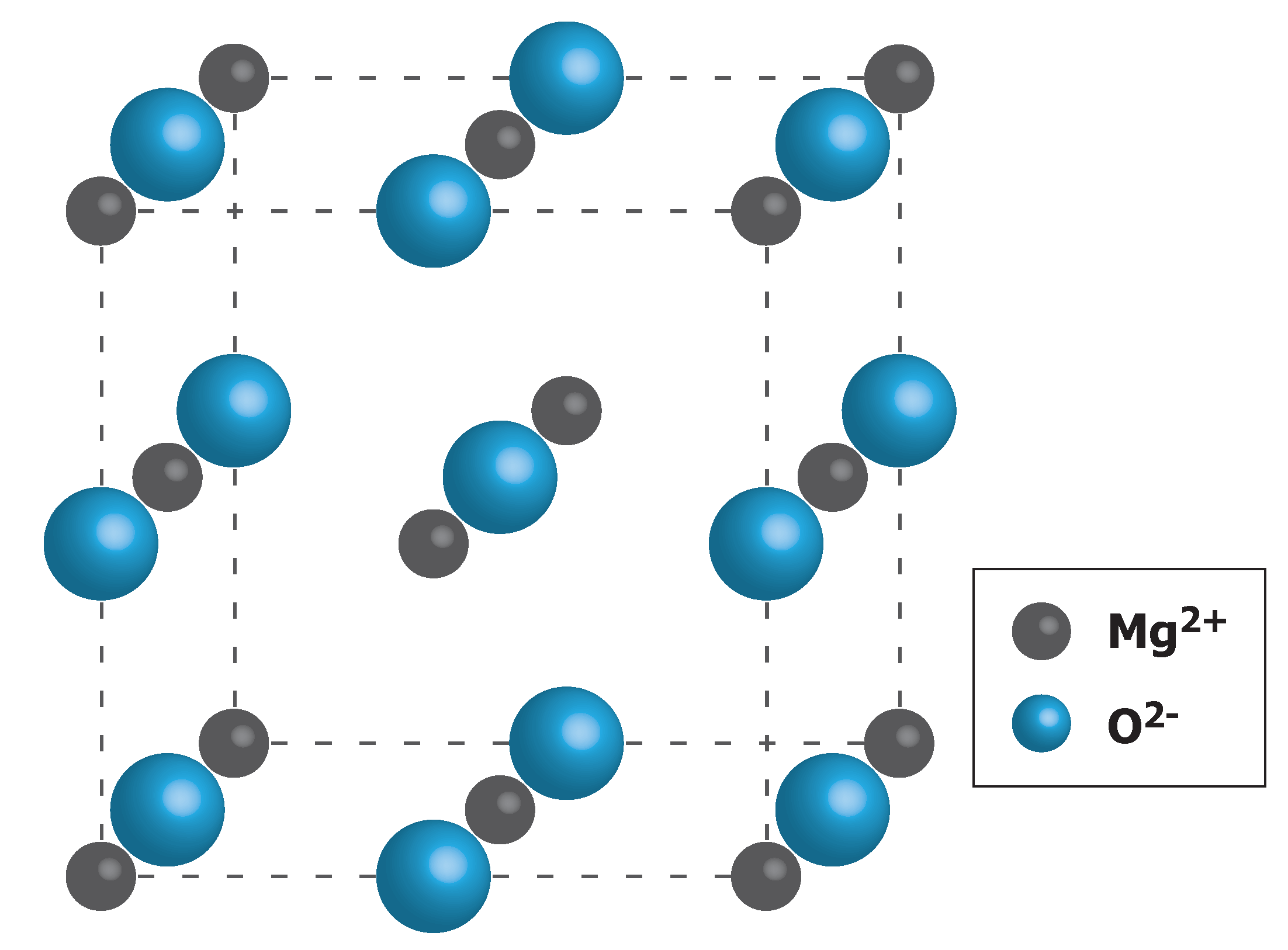


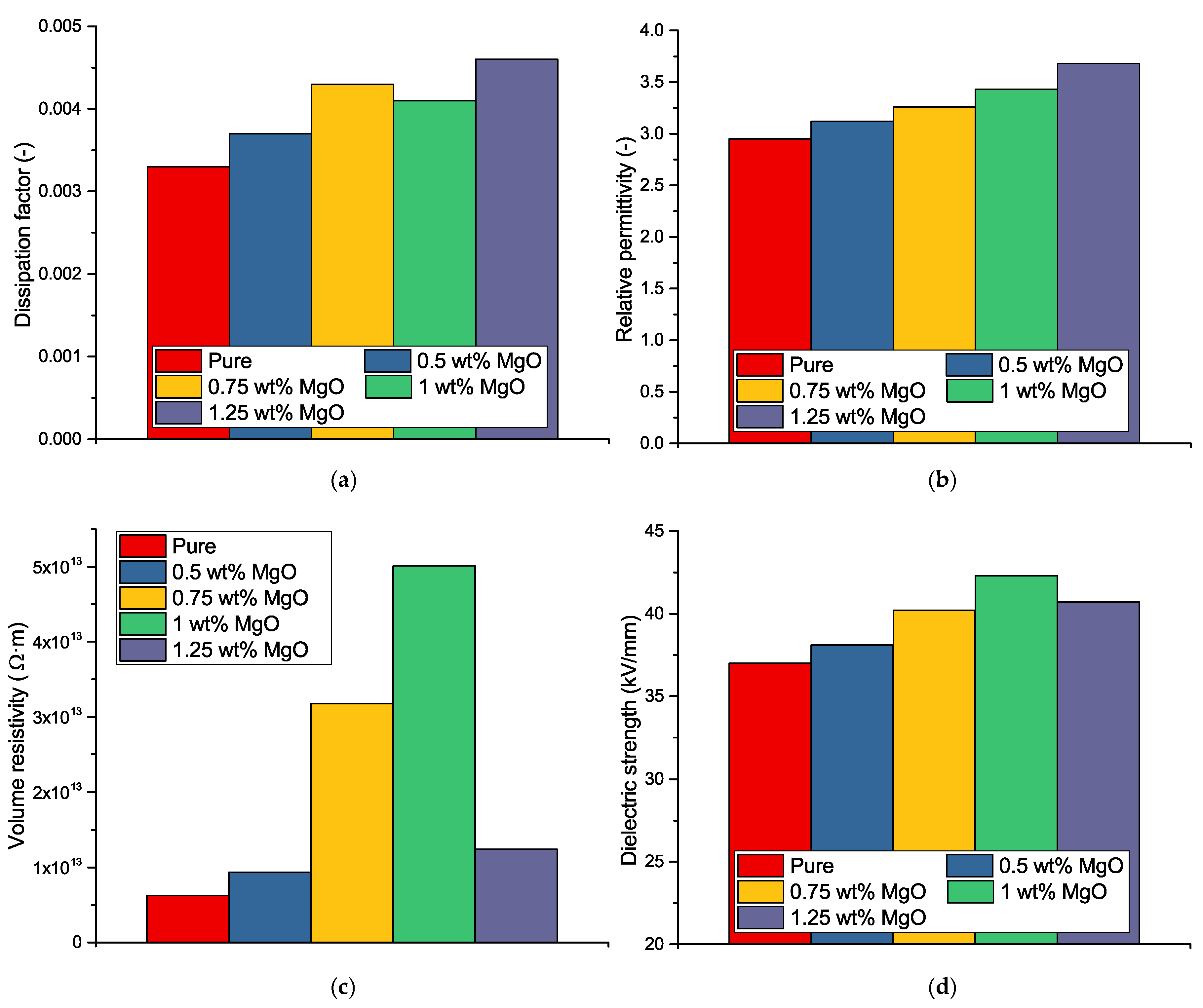
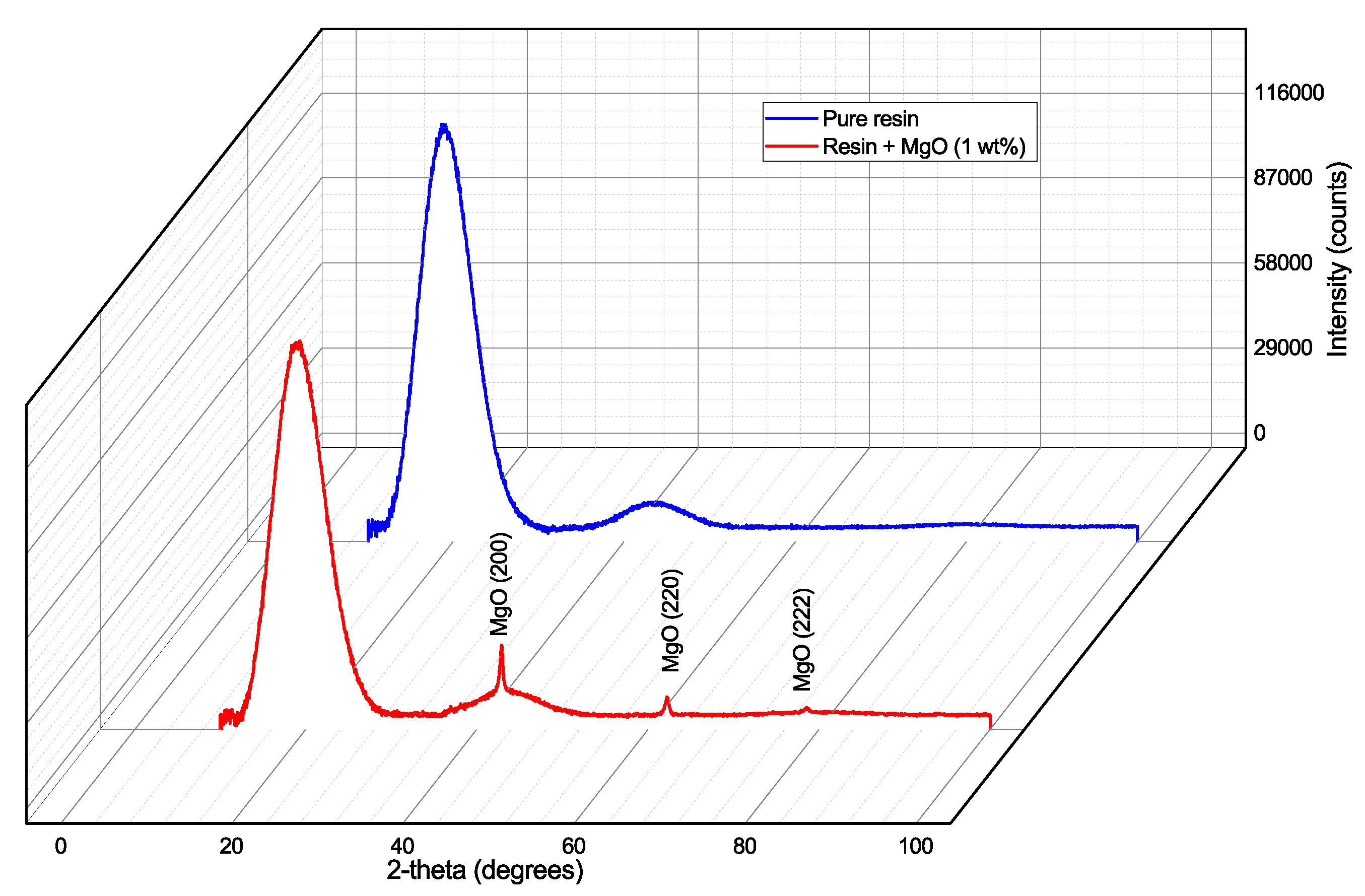

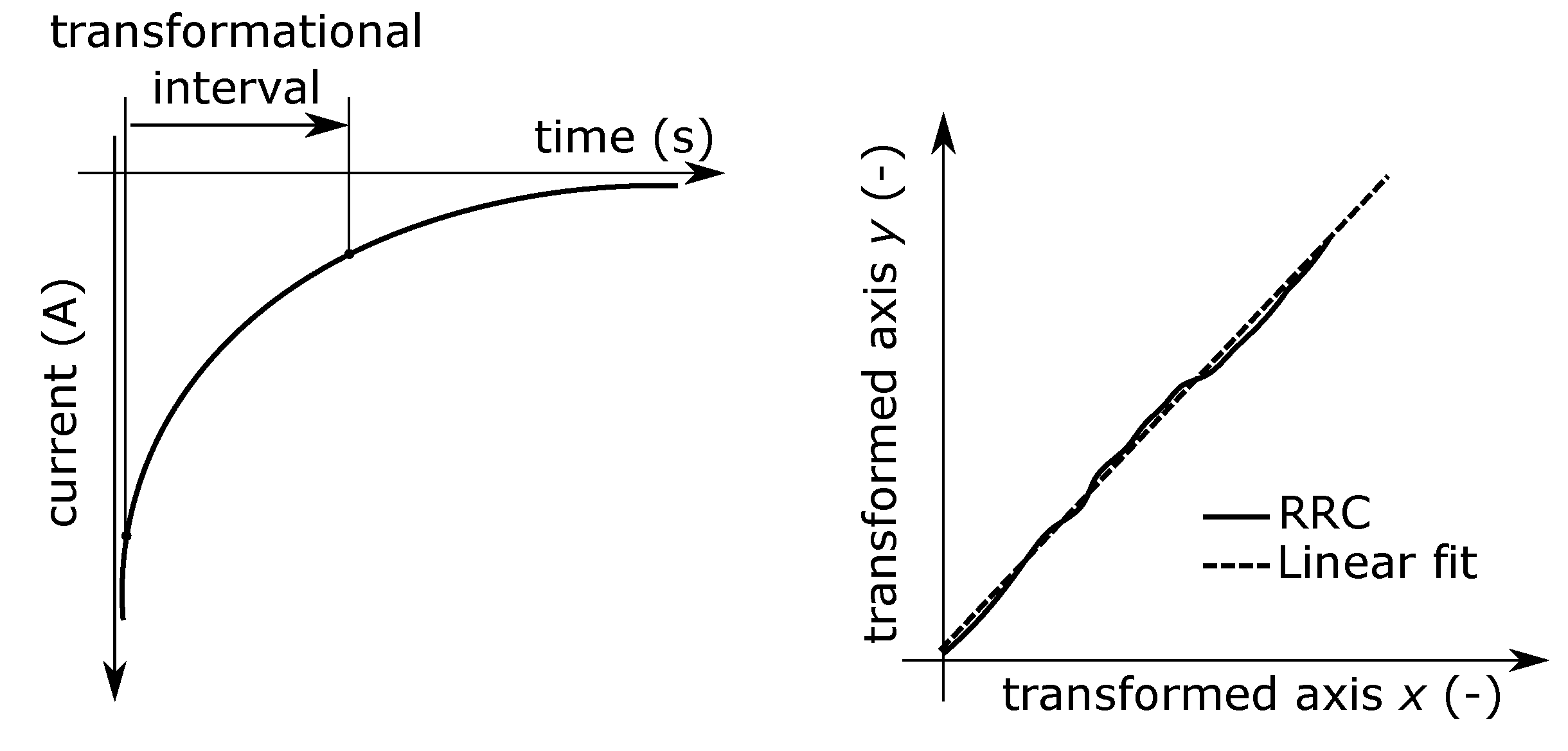
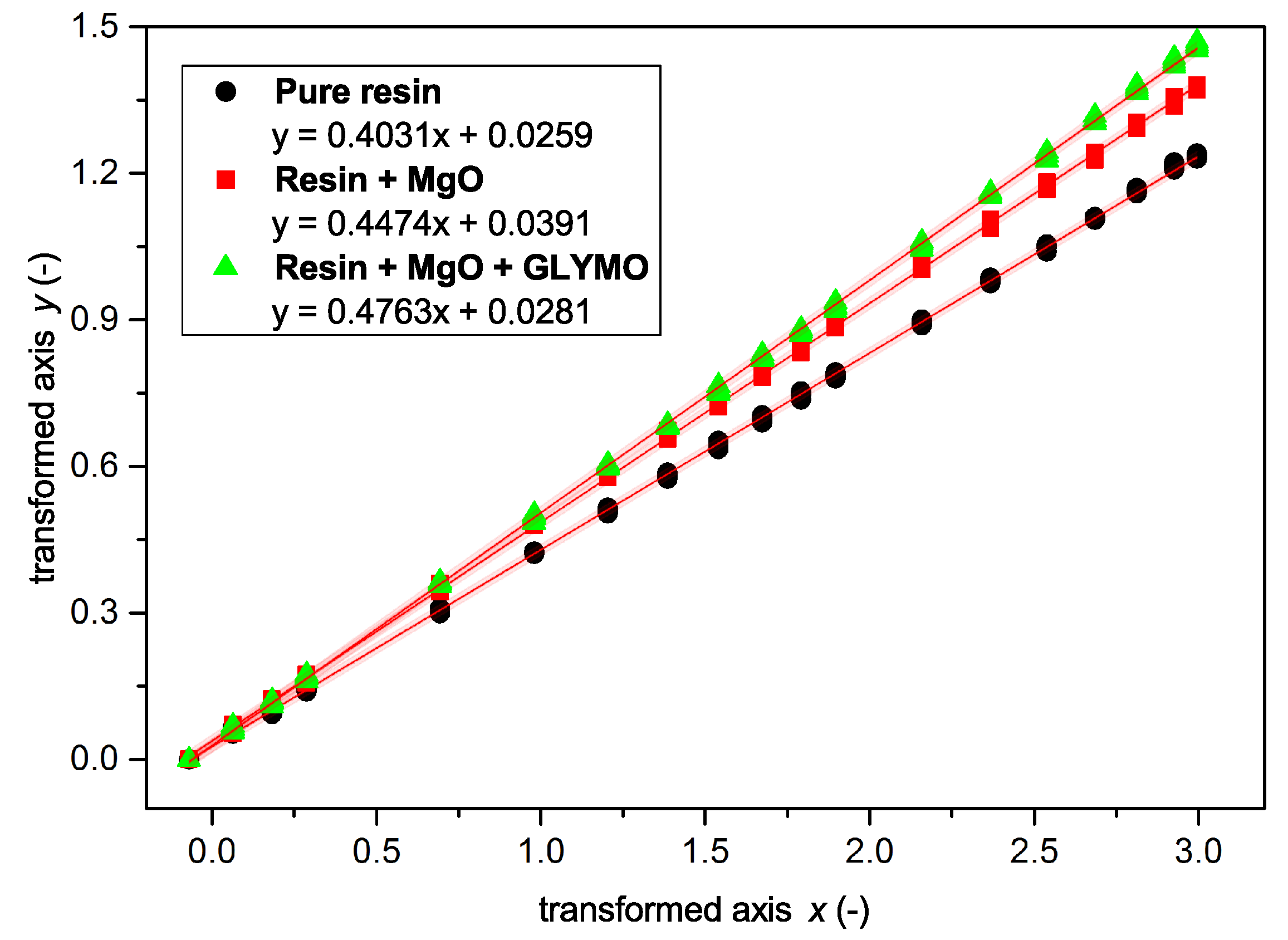
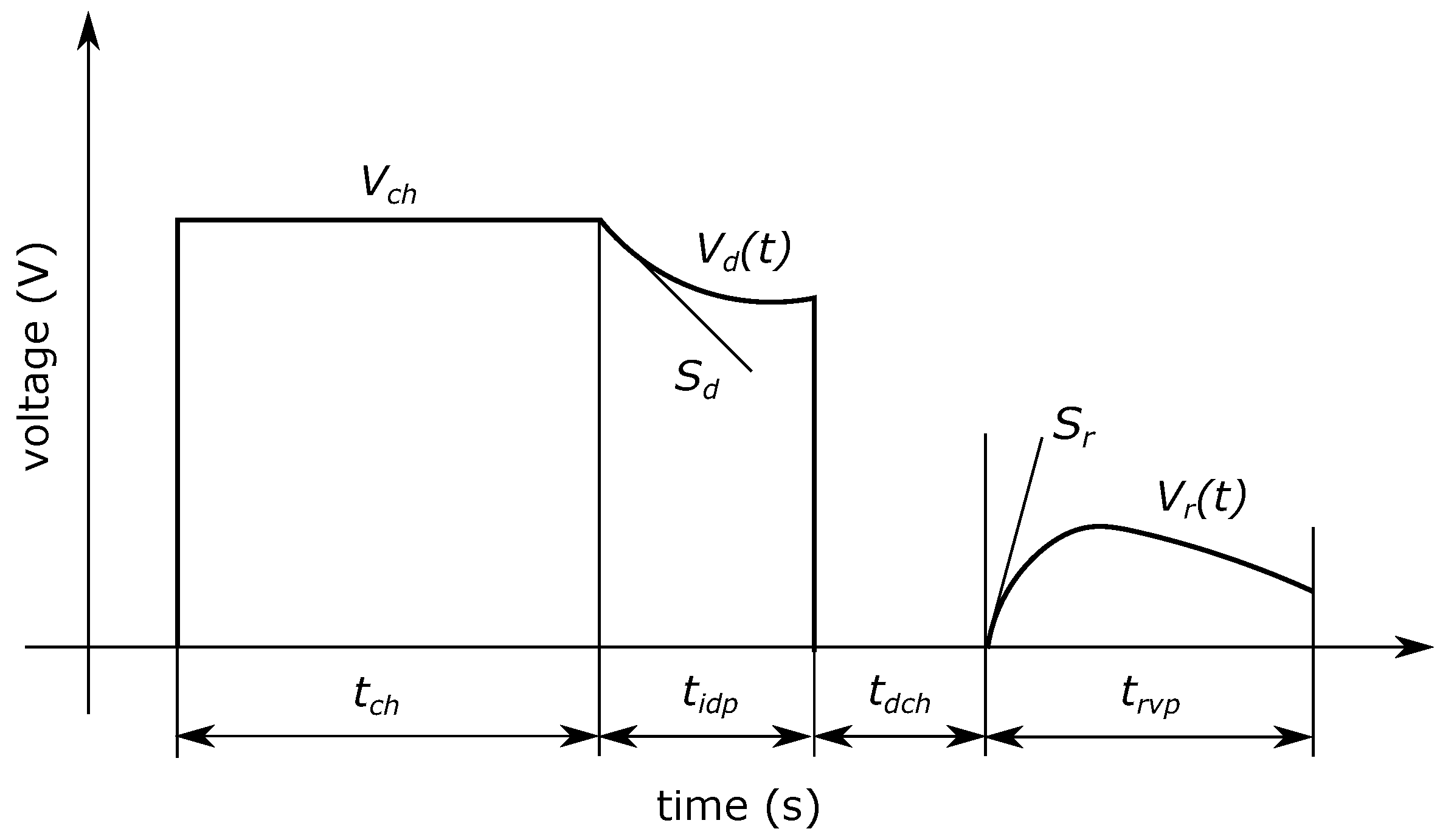
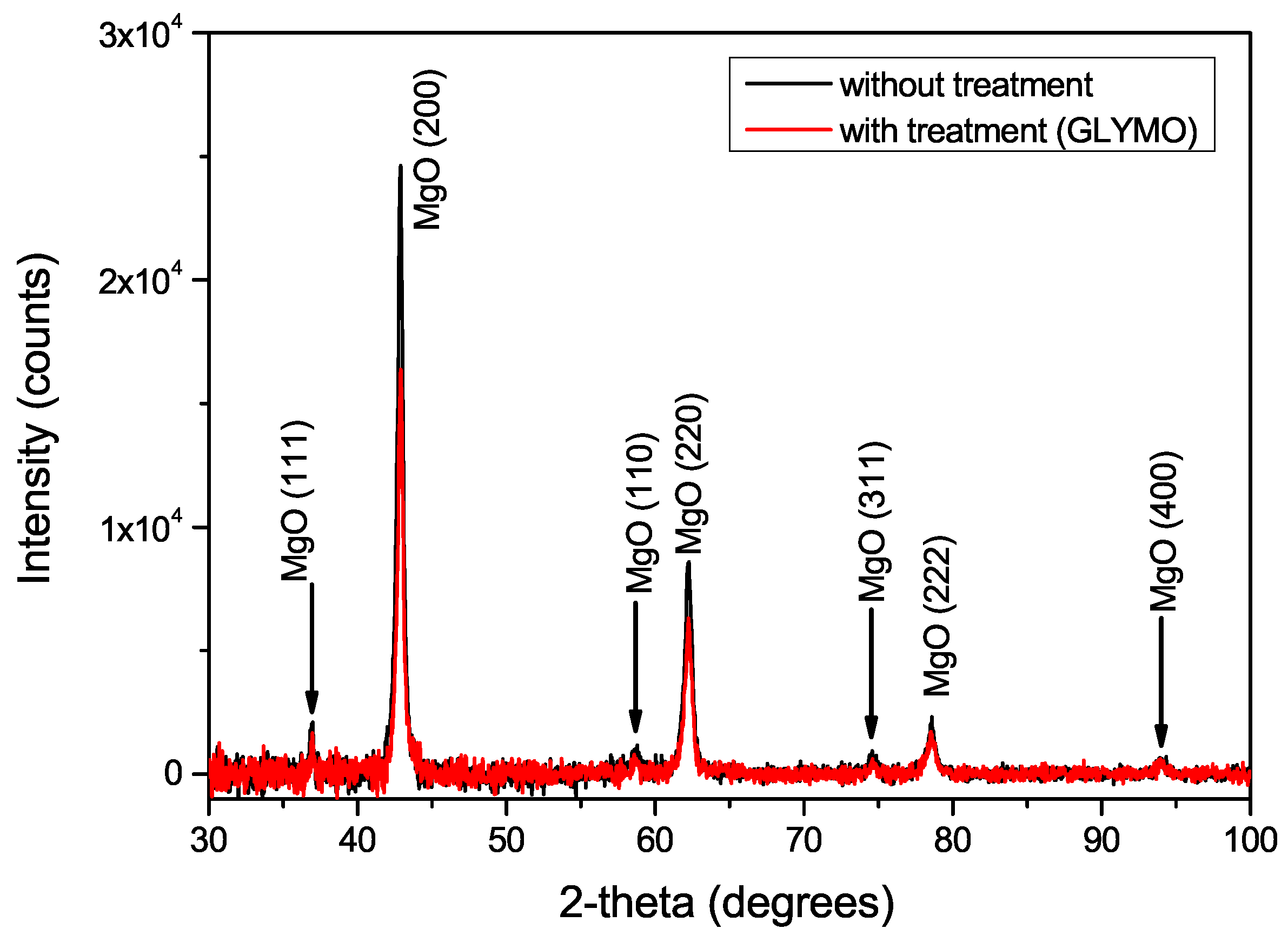
| T (C) | (-) | (-) |
|---|---|---|
| 25 | 7.77 (5.80) | 1.55 (0.205) |
| 50 | 8.43 (5.67) | 2.68 (0.0801) |
| 75 | 9.56 (5.57) | 4.90 (0.0390) |
| 100 | 8.65 (5.51) | 3.86 (0.0220) |
| 125 | 7.25 (5.46) | 1.90 (0.0145) |
| Coupling Agent | Linear Formula |
|---|---|
| Trichlorovinylsilane | H2C=CHSiCl3 |
| Triethoxyvinylsilane | H2C=CHSi(OC2H5)3 |
| -Glycidoxypropyltrimethoxysilane | C9H20O5Si |
| -Aminopropyltrimethoxysilane | H2N(CH2)3Si(OCH3)3 |
| -(3,4-Epoxycyclohexyl)-ethyl]trimethoxysilane | C14H28O4Si |
| -Mercaptopropyltrimethoxysilane | HS(CH2)3Si(OCH3)3 |
| Sample | Dissipation Factor | Relative Permittivity | Volume Resistivity | Dielectric Strength |
|---|---|---|---|---|
| Pure resin | 0.0033 | 2.95 | 6.28 × 1012 | 37 kV/mm |
| Resin + MgO | 0.0041 | 3.43 | 5.01 × 1013 | 42.3 kV/mm |
| Resin + MgO + GLYMO | 0.0036 | 3.15 | 7.14 × 1014 | 43.1 kV/mm |
| Sample | Sd(V/s) | Sr(V/s) |
|---|---|---|
| Pure resin | 5.26 | 27.69 |
| Resin + MgO | 3.20 | 16.48 |
| Resin + MgO + GLYMO | 2.25 | 15.33 |
© 2018 by the authors. Licensee MDPI, Basel, Switzerland. This article is an open access article distributed under the terms and conditions of the Creative Commons Attribution (CC BY) license (http://creativecommons.org/licenses/by/4.0/).
Share and Cite
Hornak, J.; Trnka, P.; Kadlec, P.; Michal, O.; Mentlík, V.; Šutta, P.; Csányi, G.M.; Tamus, Z.Á. Magnesium Oxide Nanoparticles: Dielectric Properties, Surface Functionalization and Improvement of Epoxy-Based Composites Insulating Properties. Nanomaterials 2018, 8, 381. https://doi.org/10.3390/nano8060381
Hornak J, Trnka P, Kadlec P, Michal O, Mentlík V, Šutta P, Csányi GM, Tamus ZÁ. Magnesium Oxide Nanoparticles: Dielectric Properties, Surface Functionalization and Improvement of Epoxy-Based Composites Insulating Properties. Nanomaterials. 2018; 8(6):381. https://doi.org/10.3390/nano8060381
Chicago/Turabian StyleHornak, Jaroslav, Pavel Trnka, Petr Kadlec, Ondřej Michal, Václav Mentlík, Pavol Šutta, Gergely Márk Csányi, and Zoltán Ádám Tamus. 2018. "Magnesium Oxide Nanoparticles: Dielectric Properties, Surface Functionalization and Improvement of Epoxy-Based Composites Insulating Properties" Nanomaterials 8, no. 6: 381. https://doi.org/10.3390/nano8060381
APA StyleHornak, J., Trnka, P., Kadlec, P., Michal, O., Mentlík, V., Šutta, P., Csányi, G. M., & Tamus, Z. Á. (2018). Magnesium Oxide Nanoparticles: Dielectric Properties, Surface Functionalization and Improvement of Epoxy-Based Composites Insulating Properties. Nanomaterials, 8(6), 381. https://doi.org/10.3390/nano8060381









